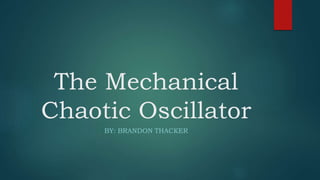
The Mechanical Chaotic Oscillator
- 1. The Mechanical Chaotic Oscillator BY: BRANDON THACKER
- 3. Deterministic vs. Stochastic Systems Stochastic Systems • Random process • Every possible state of a system is equally probable. • The state of a system is independent of its past or future states.
- 4. Deterministic Systems • A deterministic system is allowed only one unique time evolution of states for a given set of initial conditions. Proof: “The Uniqueness Theorem.” • If you have complete knowledge of the state of a system (state variables), all possible future and past states can be determined. • Deterministic systems are “in theory” completely predictable.
- 5. Characteristics of Chaos • Chaos manifests in nonlinear dynamical systems. • A chaotic system’s sensitivity to initial conditions make the system unpredictable as time evolves. • The time for which the system can be predicted (within a certain tolerance) depends on the uncertainty in the initial conditions.
- 6. So What is Chaos? • The take away: Chaos is a seemingly random unpredictable behavior present in deterministic nonlinear dynamical systems. The unpredictability comes from small differences in initial conditions leading to vastly different trajectories due to the nonlinear response of the system.
- 7. Nonlinear dynamics • Nonlinear: A nonlinear system is one that gives a response that is not directly proportional to its stimulus. • Dynamical: A dynamical system is one that evolves in time. • The MCO is a nonlinear dynamical system.
- 9. The Phase Space Portrait
- 10. Key features of the MCO -1.0 Magnetic damping (micrometer, inertial disc, and magnet) System tracking (Optical encoder and disk) Electronics and communication (microcontroller, push pull circuit and serial communication) Helmholtz chamber (field coil, drive coil, shaft and dipole) Case and materials
- 11. Case and materials Non magnetic materials • Brass and nylon fasteners • Acrylic case and coil spools • Designed in AutoCad • Cut using laser • Brass shaft
- 12. Magnetic Damping Micrometer adjuster Magnet Inertial disk Lenz’s Law
- 13. Helmholtz Chamber Field coils Drive coils
- 14. By Morn - Own work, CC BY-SA 3.0, https://commons.wikimedia.org/w/index.php?curi d=32750723
- 15. Magnetic dipole and assembly 3D-Printed assembly Dipole specs. • ¼ in separation of magnets • ¼ in depth of magnets • ¼ in diameter of the magnets
- 16. Electronics and Microcontroller Circuit components • Zeroing DAC signal • Voltage amplification • Current amplification Teensy operations • Communication • Resolving the quadrature signal from encoder • Analog drive signal
- 17. System Tracking Encoder wheel Old resolution: 360 steps New resolution: 1024 steps Optical encoder Quadrature output signal
- 19. USB-Communication • Drive Phase, position, velocity • Query responses • Commands (reporting, frequency, amplitude and much more) • Queries
- 20. Table of commands for the MCO
- 21. Digital to analog converter (DAC) Sine wave lookup table (Res. = 256) Teensy’s on board DAC To circuit
- 22. Shifting and amplifying From Teensy Difference amplifierVDAC = (0 - 3.3)v Maximum D.C. VMAX = 3.3v Class B Current amplifier VOUT = ±1.65v Drive coils VOUT = VDAC – 1/2VMAX ICOIL = ~5A VCOIL = ± 10v
- 23. Circuit Diagram
- 24. MCO (1.0) Results Simple harmonic motion driven at the natural frequency
- 25. Limit cycles and transient behavior The dying out of transient motion
- 26. From simple motion to chaos Simple motion at 0.76 (rads/sec) Chaos at 0.82 (rads/sec)
- 31. Acknowledgements • Contributors to the Chico State PSRI fund. • Dr. Eric Ayars, program advisor and mentor • Tucker Hartland, multifaceted wizardry • Bill Koperwhats, Laser cutter • Jadie Lee, Physics machine shop • Scott Brogden, CSUC Mechanical Engineering dept.
Editor's Notes
- A nonlinear system is such that the response of the system is not linearly proportional to the input action to the system.
- Just because the system is unpredictable does not mean it is random
- Explain the MCO: Damping, Field and Drive Coils Picture at right is looking down on the helmholtz chamber damping not shown
- Play Poincare’ evolution movie
- *3mm thick, * Laminated coil spools(6mm x 6mm) cross section
- the field is within 1% of its central value B0. The eight contours are for field magnitudes of 0.5 B0, 0.8 B0, 0.9 B0, 0.95 B0, 0.99 B0, 1.01 B0, 1.05 B0, and 1.1 B0.
- the field is within 1% of its central value B0. The eight contours are for field magnitudes of 0.5 B0, 0.8 B0, 0.9 B0, 0.95 B0, 0.99 B0, 1.01 B0, 1.05 B0, and 1.1 B0
- DAC output is from ( 0 to 3.3)V
- Capture mode: Hold all system parameters constant but one and sweep through values of the variable parameter. ( Amplitude, frequency) Note: asymmetry
- * A frequency jump of 0.06 (rads/sec)* * wrapping in angle*